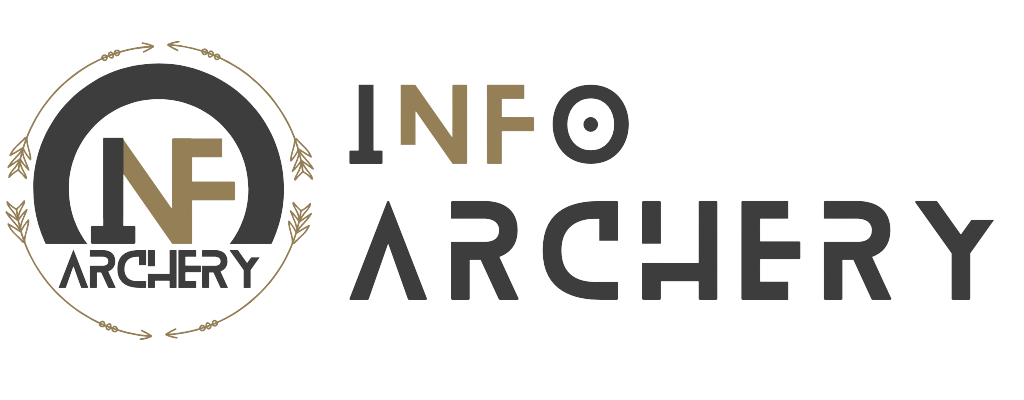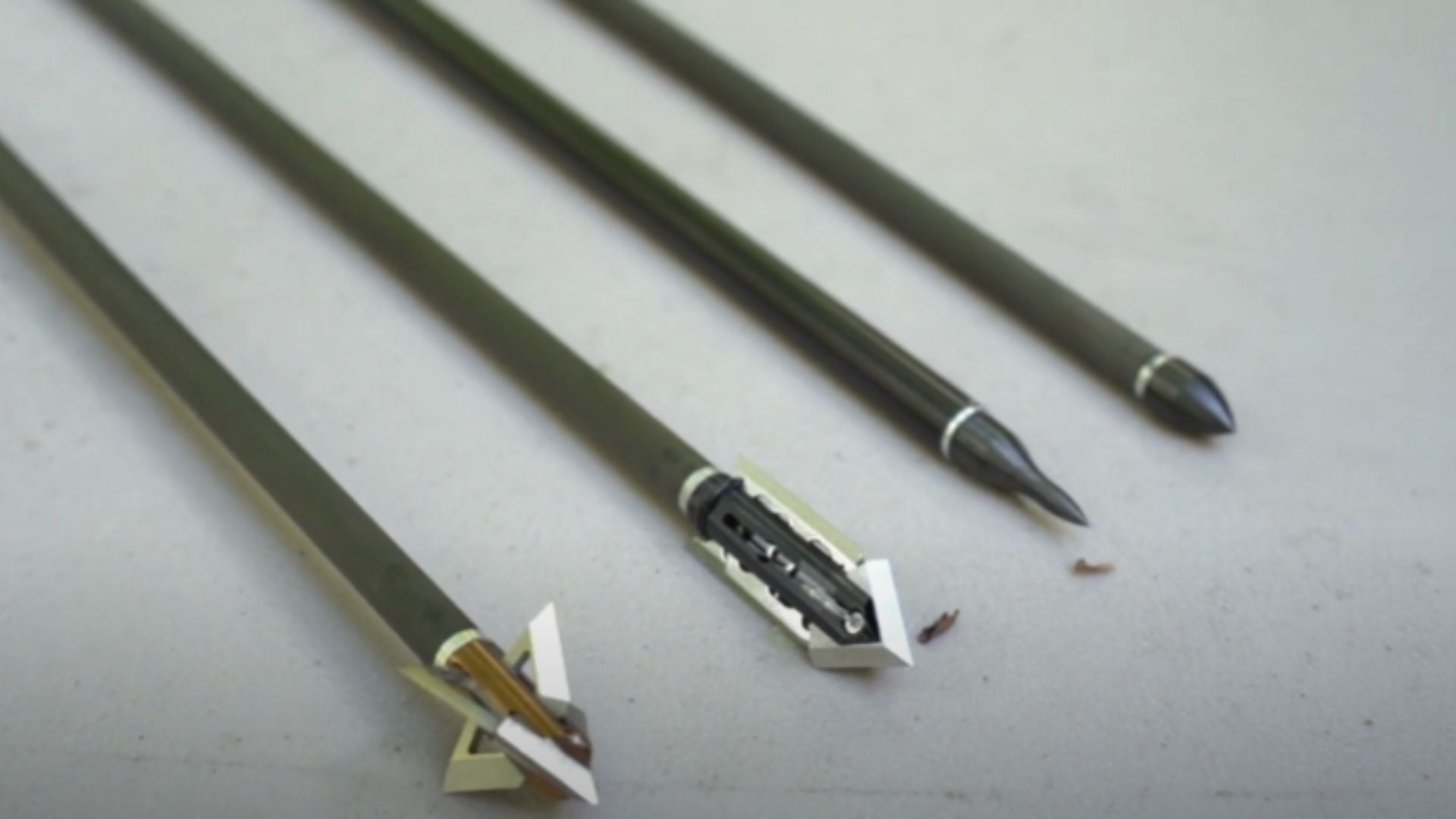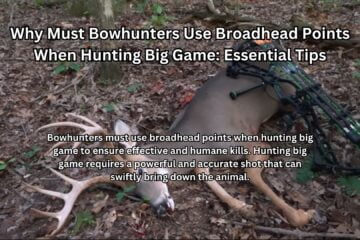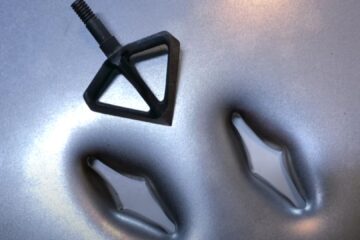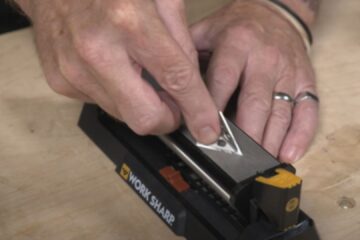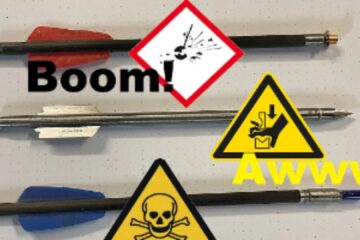An arrow with a broadhead kills big game by penetrating vital organs, causing rapid blood loss and internal damage, resulting in the animal’s eventual demise. Hunted animals such as elk, deer, or moose are targeted precisely to ensure an ethical and humane kill.
The broadhead, which is the sharp metal tip attached to the arrow shaft, expands upon impact, creating a larger wound channel and maximizing the likelihood of a swift and clean kill. With its ability to cut through flesh and bone, the broadhead arrow delivers a lethal blow to big game, ensuring a successful hunt.
Hunters must aim meticulously to hit vital areas and make every effort to retrieve and utilize the harvested animal responsibly.
The Lethal Design: Broadheads At The Tip
Arrow broadheads are designed to be lethal, making them effective in killing big game. With their sharp and penetrating tips, these broadheads can cause devastating damage and ensure a quick and humane kill. Their construction and design maximize their effectiveness, allowing hunters to take down their targets with precision and efficiency.
When it comes to taking down big game, an arrow with a broadhead is a truly deadly combination. The broadhead, the sharp tip of the arrow, is specifically designed to maximize its effectiveness and ensure a lethal outcome. Let’s explore the construction, features, and types of broadheads that make them so effective in hunting.
Construction And Features Of Broadheads:
- Broadheads consist of a steel tip that is attached to the shaft of the arrow. This tip is shaped to create maximum damage upon impact with the target.
- The main purpose of a broadhead is to cut through the vital organs and tissues of the animal, leading to a quick and humane kill.
- The cutting edges of the broadhead are sharpened to razor-like precision, enabling them to penetrate the animal’s hide and flesh with ease.
- Most broadheads have multiple cutting blades, with three and four blades being the most common configurations. This ensures a wider wound channel and increases the chances of hitting vital organs.
- To add strength and durability, broadheads are typically made from high-quality stainless steel or carbon steel materials.
- Some broadheads feature extra design features like ferrules or chisel points. Ferrules are metal sleeves that encase the arrow shaft, providing additional stability and strength. Chisel points have a more elongated shape that enhances penetration.
The lethal design of broadheads is crucial for successful big game hunting. Their construction and features, as well as the different types available, ensure maximum effectiveness when it comes to taking down large animals. Whether you prefer the reliability of fixed blade broadheads, the accuracy of mechanical broadheads, or the versatility of hybrid broadheads, there is a broadhead out there to suit every hunter’s needs.
Penetration Power: Unleashing Devastating Force
Unleash devastating force and learn how an arrow with a broadhead is able to penetrate with the power to take down big game. Discover the deadly effectiveness of this hunting weapon and understand its ability to deliver a lethal blow.
Arrow Speed And Kinetic Energy:
- The speed of an arrow, along with its kinetic energy, plays a crucial role in the effectiveness of killing big game.
- When an arrow is shot with high speed, it transfers more kinetic energy to the target upon impact, causing greater damage and higher chances of a clean kill.
- A faster arrow also allows for a shorter flight time, reducing the chances of the game reacting and moving with enough time to escape.
The Role Of Draw Weight:
- Draw weight refers to the force required to draw back a bowstring fully. It directly influences the power and speed of an arrow.
- A higher draw weight results in a more powerful shot, increasing the arrow’s velocity, kinetic energy, and penetration potential.
- Big game hunting typically requires a higher draw weight to effectively penetrate the thick hide and muscles of the animals.
Factors Affecting Arrow Speed:
Several factors contribute to the speed of an arrow, which ultimately determines its penetration power.
- Bow efficiency: The efficiency of the bow itself, including its design, materials, and technology, influences how much energy can be efficiently transferred to the arrow.
- Draw length: A longer draw length allows for a greater distance for the bowstring to accelerate the arrow, resulting in higher speed.
- Arrow weight: Lighter arrows generally achieve higher speeds, as they require less energy to propel them forward.
The Science Behind Deep Penetration:
- Deep penetration is crucial to ensure a lethal shot on big game. It involves the arrow penetrating through the animal’s vital organs and reaching the necessary depth.
- The arrow’s ability to penetrate is determined by its kinetic energy, the broadhead’s cutting diameter, and the force needed to overcome the resistance of the animal’s tissues and bones.
- Proper shot placement, with the arrow hitting the vital organs, coupled with sufficient kinetic energy, ensures a quick and humane kill.
Cutting Diameter And Blade Placement:
- The cutting diameter of a broadhead refers to the width of the blades that open upon impact. It significantly affects the wound channel size and hemorrhaging.
- A broadhead with a larger cutting diameter creates a larger wound channel, increasing the chances of disabling the animal quickly.
- Blade placement is equally important, as hitting the vital organs or major blood vessels ensures maximum damage and blood loss.
Importance Of Momentum:
- Momentum refers to the combined effect of the arrow’s weight and speed. It plays a vital role in big game hunting, contributing to deep penetration and effective killing.
- A heavier arrow, accompanied by high speed, retains more momentum upon impact. This ensures the arrow continues forward, driving through the animal’s tissues and organs.
- Adequate momentum helps overcome any resistance encountered, ensuring the arrow reaches its intended target and imparts maximum damage.
Remember, to increase the chances of outranking other websites, make sure to provide relevant and valuable information while maintaining a conversational tone throughout the blog post.
Inflicting Fatal Wounds: Terminal Performance Unveiled
‘Inflicting Fatal Wounds: Terminal Performance Unveiled’ delves into the mechanics of arrow with a broadhead’s lethal potential on big game. This article explores the intricacies of how these arrows bring down large animals effectively.
When it comes to hunting big game, an arrow equipped with a broadhead plays a crucial role in inflicting fatal wounds. To understand how this works, let’s delve into the damage caused by broadheads and the specific vital organs they target.
Damage Caused By Broadheads
Broadheads are designed to cause significant damage upon impact, and they achieve this by cutting and slicing through tissue. This results in various types of wounds that can ultimately prove fatal to the game being hunted. Here’s how it happens:
Cutting and slicing through tissue:
- Broadheads feature razor-sharp blades that efficiently cut through the skin and tissues.
- The slicing action enlarges the wound channel and causes extensive trauma to surrounding tissues.
Vital Organs Targeted
To ensure a quick and humane kill, hunters aim for specific vital organs when using broadheads against big game. These organs play a critical role in the animal’s survival, and targeting them is essential for an effective kill. The primary vital organs targeted by hunters using broadheads include:
Heart and lungs:
- Targeting the heart and lungs is highly effective in causing rapid incapacitation.
- A well-placed shot to these vital organs disrupts the animal’s circulatory and respiratory systems, leading to a quick and ethical kill.
Liver and diaphragm:
- Striking the liver and diaphragm area can cause severe internal bleeding, impairing the animal’s ability to function.
- The liver is an organ rich in blood supply, making it an ideal target for inflicting fatal wounds.
Spinal cord:
- Severing the spinal cord instantly immobilizes the animal, preventing it from escaping or posing a threat.
- It results in immediate paralysis and ensures a humane kill with minimal suffering.
Blood Loss And Shock
Broadheads not only cause damage to vital organs but also induce significant blood loss that leads to shock, further hastening the demise of the targeted big game. Let’s explore the effects of blood loss and the role it plays in achieving terminal performance.
Arterial bleeding:
- Broadheads can sever major blood vessels, leading to rapid arterial bleeding.
- This results in a substantial loss of blood, causing the animal to weaken and eventually succumb to shock.
Hemorrhaging effects:
- The deep penetrating capabilities of broadheads can create extensive hemorrhaging within the animal’s body.
- Hemorrhaging disrupts normal blood flow, depriving vital organs of oxygen and nutrients, ultimately leading to fatal consequences.
By leveraging the damage caused by broadheads and targeting vital organs, hunters ensure a swift and ethical kill. The combination of cutting through tissue, damaging critical organs, and inducing blood loss and shock results in the terminal performance required for hunting big game effectively.
Accuracy Matters: Hitting The Mark
Do you ever wonder how an arrow with a broadhead can effectively take down big game? Discover the lethal accuracy behind this hunting technique.
Importance Of Proper Shooting Form:
- Proper shooting form is crucial when it comes to hitting the mark and ensuring an effective kill shot on big game.
- Maintaining a consistent and steady posture while shooting helps in achieving greater accuracy and precision.
- It involves keeping your body aligned with the target and maintaining a stable grip on the bow.
- By mastering the proper shooting form, you enhance your chances of hitting vital areas, increasing the effectiveness of the broadhead.
Aiming Techniques:
- Aiming is the cornerstone of accuracy and successful big game hunting.
- One commonly used technique is the “pin and focus” method, where the archer aligns the sight pin with the target and maintains a sharp focus on the spot they want to hit.
- Another technique is gap shooting, which involves estimating the distance to the target and adjusting the aim accordingly.
- With practice and experience, archers develop their preferred aiming method that works best for them.
Consistency In Anchor Points:
- Consistency in anchor points is vital for accurate shooting.
- An anchor point is a reference point on the archer’s face where they draw the bowstring consistently during each shot.
- By finding and maintaining a consistent anchor point, you ensure that your shots are consistent, leading to enhanced accuracy.
- Common anchor points include the corner of the mouth, the tip of the nose, or the cheekbone.
Understanding The Trajectory Of An Arrow:
- The trajectory of an arrow refers to its path from the moment it leaves the bow until it reaches the target.
- Understanding the trajectory is essential for accurate shooting.
- Generally, arrows follow a curved path, and factors such as distance, arrow speed, and wind conditions affect the trajectory.
- By familiarizing yourself with the anticipated trajectory, you can adjust your aim accordingly to hit the target precisely.
Account For Shot Distance And Angle:
- Shot distance and angle significantly impact the accuracy of the shot.
- Shooting at different distances requires adjusting your aim to compensate for drop and travel time.
- Additionally, shooting at an angle introduces the effect of gravity, sometimes resulting in poor shot placement if not accounted for.
- By practicing shooting at varying distances and angles, you improve your skill in making the necessary adjustments for more accurate shots.
Adjustments For Uphill And Downhill Shots:
When shooting uphill or downhill, it becomes crucial to make proper adjustments to ensure accuracy.
- Uphill shots tend to cause the arrow to hit higher than expected, so aiming lower can compensate for this effect.
- On the other hand, downhill shots require aiming slightly higher to adjust for the downward trajectory of the arrow.
- Understanding these adjustments aids in making precise shots regardless of the terrain.
Remember, achieving accuracy is key when hunting big game with an arrow and a broadhead. By mastering proper shooting form, utilizing effective aiming techniques, maintaining consistent anchor points, understanding arrow trajectory, accounting for shot distance and angles, as well as making adjustments for uphill and downhill shots, you increase the likelihood of hitting the mark and ensuring a successful kill.
Targeting Vulnerable Spots: Deadly Precision
An arrow with a broadhead delivers precise and lethal force to target vulnerable spots and take down big game with deadly precision. Discover how this technique ensures a successful kill.
Anatomy Of Big Game Animals
Big game animals have a complex anatomy with various vital organs and vulnerable spots that can be targeted for a deadly kill. Understanding their anatomy is crucial for hunters to ensure ethical and effective shots.
Here are some key points:
- Heart and lungs: Aiming for the heart and lungs is generally considered the best shot placement, as it leads to a quick and humane kill. These organs are located behind the front shoulder of the animal.
- Brain: A shot to the brain instantly incapacitates the animal, preventing any suffering. However, it is a small target and requires exceptional accuracy.
- Spine: A well-placed shot to the spine can result in immediate paralysis, stopping the animal in its tracks. However, the spine is a narrow target that requires precise shooting skills.
- Blood vessels: Hitting major blood vessels can cause massive internal bleeding, leading to a swift and ethical kill. Understanding the location of these vessels is essential for effective shots.
Vital areas to aim for:
- Heart: Located just behind the front shoulder, aiming for the heart ensures a rapid and efficient kill.
- Lungs: Situated directly behind the heart, targeting the lungs maximizes damage and incapacitates the animal quickly.
- Brain: A precise shot to the brain results in instant incapacitation, sparing the animal from unnecessary suffering.
- Spine: Hitting the spine can immobilize the animal on the spot, preventing it from escaping or causing further harm.
- Blood vessels: Targeting major blood vessels can lead to massive internal bleeding, rapidly incapacitating the animal.
Identifying Shot Opportunities
When hunting big game animals, hunters must be able to identify and seize shot opportunities that offer a high chance of success.
Here are some common shot opportunities and their characteristics:
Broadside shot: This shot presents itself when the animal is facing perpendicular to the hunter. Key features include:
- Targeting the vital organs of the animal, such as the heart and lungs, becomes relatively accessible.
- Good shot placement minimizes the risk of the animal fleeing and helps ensure a quick kill.
- Hunters should aim slightly behind the animal’s front shoulder to optimize shot placement.
- Proper positioning and calmness are essential to taking advantage of this shot opportunity.
Quartering away shot: This shot occurs when the animal is facing slightly away from the hunter. Important elements of this shot opportunity include:
- Careful placement of the shot, aiming for the vitals, as the animal’s body presents a slight angle.
- The arrow trajectory should penetrate the chest cavity and damage the vital organs effectively.
- Hunters need to exercise patience, waiting for the right moment to take the shot.
- Proper shot placement increases the likelihood of a quick and lethal kill.
Frontal shot: A frontal shot opportunity arises when the animal is facing directly toward the hunter. Consider the following points:
- This shot is particularly challenging and requires exceptional accuracy to hit vital organs.
- Aiming for the brain or heart is necessary to avoid injuring the animal without causing a swift kill.
- Shots should only be taken when the animal’s head is in an upright position, providing better access to vital areas.
- Hunters must exercise caution, as incorrect shot placement can result in non-fatal injuries and a potentially dangerous situation.
Follow-Up Shots
After making an initial shot, it is crucial for hunters to be prepared for potential follow-up shots. Here are some key considerations:
- Assessing the animal’s reaction: Observing the animal’s behavior after the shot can indicate whether a follow-up shot is necessary. Signs of distress, a lack of immediate incapacitation, or attempts to flee may signal the need for another shot.
- Precision and quick action: If a follow-up shot is required, it should be delivered with the utmost accuracy and promptly. This ensures a humane and ethical kill while minimizing the suffering of the animal.
- Maintaining composure: Staying calm and composed during follow-up shots is vital to making accurate and effective shots. Panic or rushing can lead to poorly placed shots and prolonged suffering.
- Safety first: Prioritize safety at all times and be mindful of the surroundings. Maintain awareness of other hunters, potential obstacles, and ensure a safe shooting angle.
- By understanding the anatomy of big game animals, identifying shot opportunities, and executing precise follow-up shots, hunters can ethically and effectively bring down their quarry. Knowing the vital areas to aim for and recognizing shot opportunities maximizes the chances of a humane and successful hunt.
Frequently Asked Questions For How Does An Arrow With A Broadhead Kill Big Game
How Does A Broadhead Kill a Big Game?
A broadhead kills big game by making a precise and lethal impact on vital organs.
How Do Broadhead Arrows Work?
Broadhead arrows work by using their sharp blades to cut through the target, inflicting a lethal wound.
How Much Damage Does An Arrow Do To A Human?
An arrow can cause significant damage to a human, potentially leading to severe injury or death.
How Does An Arrow Kill A Deer?
An arrow kills a deer by penetrating its vital organs, causing extensive internal bleeding and organ damage, ultimately leading to the deer’s death.
Conclusion
The use of an arrow with a broadhead can effectively kill big game animals by delivering a lethal wound. The design of a broadhead allows for maximum tissue damage, causing extensive bleeding and ultimately leading to the animal’s demise. With sharp blades that cut through flesh and organs, the broadhead leaves a devastating impact on its target.
Hunters carefully select broadheads based on their intended game, ensuring that the broadhead’s weight, shape, and cutting diameter are suitable for a quick and humane kill. While the effectiveness of a broadhead may vary based on shot placement, distance, and other factors, proper technique and practice can help increase accuracy and success.
Understanding how an arrow with a broadhead works to kill big game is important for ethical and responsible hunting practices. By learning about the anatomy of animals and practicing precision in shooting, hunters can strive for clean kills and minimize unnecessary suffering.
